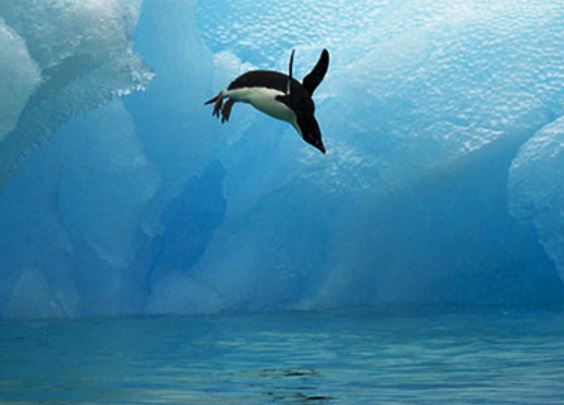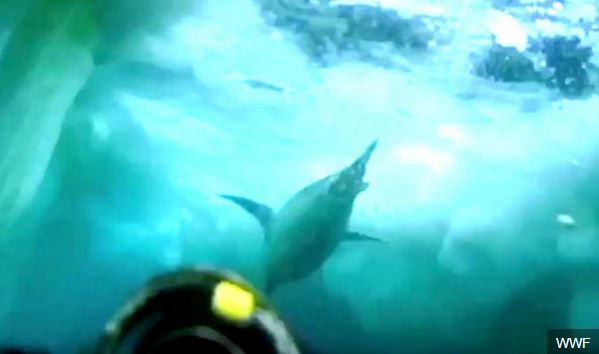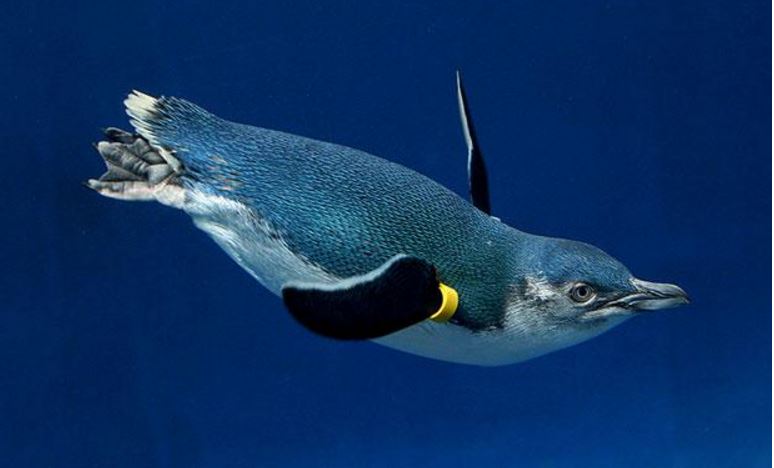Cameras fitted to Adélie penguins by researchers for the French and Japanese national Antarctic programmes show us how they hunt and live. The tiny 15gm cameras have produced a fascinating video of hungry penguins’ lives under water as they chase their prey beneath the Antarctic ice (video coming soon).
In a separate study, Australian scientists fitted tiny cameras on Little Penguins (Eudyptula minor), which allowed them to watch a video (see bottom of page) showing how they hunt and what kind of prey they go for. Little penguins form groups when hunting because it gives them a greater chance of capturing their prey.
Grace Sutton, who completed the project on the little penguins as part of her honours at Deakin University in Geelong, Australia, said:
“What we did find was that when hunting in groups little penguins appeared to have more chance of finding their prey than when on their own. But finding prey is only half the challenge. The penguins had no more chance of capturing and then eating a meal when they were in groups.”
 Adélie penguin turn from clumsy walkers into master swimmers as soon as they hit the sea. (Image: wwf.org.uk)
Adélie penguin turn from clumsy walkers into master swimmers as soon as they hit the sea. (Image: wwf.org.uk)
Adélie and Little Penguins live in different places
The Adélie penguin is common along the entire Antarctic coast, which is their only residence. The little penguin, the smallest of all penguins, is found on the coastlines of southern Australia and New Zealand, with possible records from Chile.
The Adélie penguin (Pygoscelis adeliae) images were captured in ‘The Land of Adélies’ (Terre Adélie) – researchers recovered the cameras after the penguins returned to their nests.
Polar programme manager for WWF-UK Rod Downie, explained that 2014’s John Lewis Christmas advert, featuring Monty and Mabel the Adélie penguins, helped support the study.
Monty and Mabel were computer-generated creations. This new video is the real thing, and filmed by the penguins themselves. It shows how this fascinating and slightly clumsy land walker, becomes a master swimmer after diving into the sea.
Mr. Downie said:
“Monty-mania last Christmas helped us to support this important scientific research using new technology which gives us incredible insight into where and how penguins feed.”
“Ultimately, this will help to safeguard the future of these amazing birds, which are threatened by predicted climate change.”
 According to penguinscience.com, Adélie Penguins normally stay under water for 2-3 minutes while feeding, although the longest recorded submergence is almost 6 minutes. They frequently dive to 40-50 metres but occasionally to 120-140 metres deep. The deepest recorded dive by this species is 170 metres. In this image, the penguin is coming up for air. (Image: WWF)
According to penguinscience.com, Adélie Penguins normally stay under water for 2-3 minutes while feeding, although the longest recorded submergence is almost 6 minutes. They frequently dive to 40-50 metres but occasionally to 120-140 metres deep. The deepest recorded dive by this species is 170 metres. In this image, the penguin is coming up for air. (Image: WWF)
Conservationists say that apart from being fun to watch, the video gives us important insights into penguins’ feeding strategies at a time when the Adélie species has been listed as Near Threatened.
Adélie penguins and climate change
Although many conservationists blame climate change for the Adelie penguin’s uncertain future, predicting a 30% decline in their global population within the next three generations, a recent study carried out by Australian scientists found that shrinking Antarctic glaciers may, in fact, benefit them.
In East Antarctica, where glaciers are shrinking, the penguin population has increased considerably. The penguins nest on ice-free land along the Antarctic coastline. Deglaciation means more land for them to nest on. Foraging for food for their babies and juveniles also becomes easier when there is less sea ice.
 The Penguin Foundation says little penguins must go to sea to find food, preferring to eat fish such as anchovies, pilchards, red cod, warehou, and barracouta – and a small quantity of squid. (Image: www.zoo.org.au)
The Penguin Foundation says little penguins must go to sea to find food, preferring to eat fish such as anchovies, pilchards, red cod, warehou, and barracouta – and a small quantity of squid. (Image: www.zoo.org.au)
Over the past 20 years the Adélie penguin population has more than doubled. However, scientists say this will soon change, and their numbers are likely to plummet again unless drastic action is taken.
Heather Lynch, Assistant Professor of ecology at Stony Brook University in New York, published a study last year which showed that the Adelie Penguin population was 53% higher than previous estimates.
However, she warned that without concerted efforts to conserve their food supply, their fate could change rapidly.
“While we celebrate the news that Adélie penguin populations are thriving, learning of these population booms reinforces the need to protect the Antarctic food web.”
Citation: “Benefits of Group Foraging Depend on Prey Type in a Small Marine Predator, the Little Penguin,” Grace J. Sutton , Andrew J. Hoskins & John P. Y. Arnould. PLOS ONE. 16 December, 2015. DOI: DOI: 10.1371/journal.pone.0144297.
Video – Penguins with cameras hunting for food underwater
Australian scientists placed tiny cameras on little penguins (Eudyptula minor) and were able to observe their hunting strategies and prey types.

